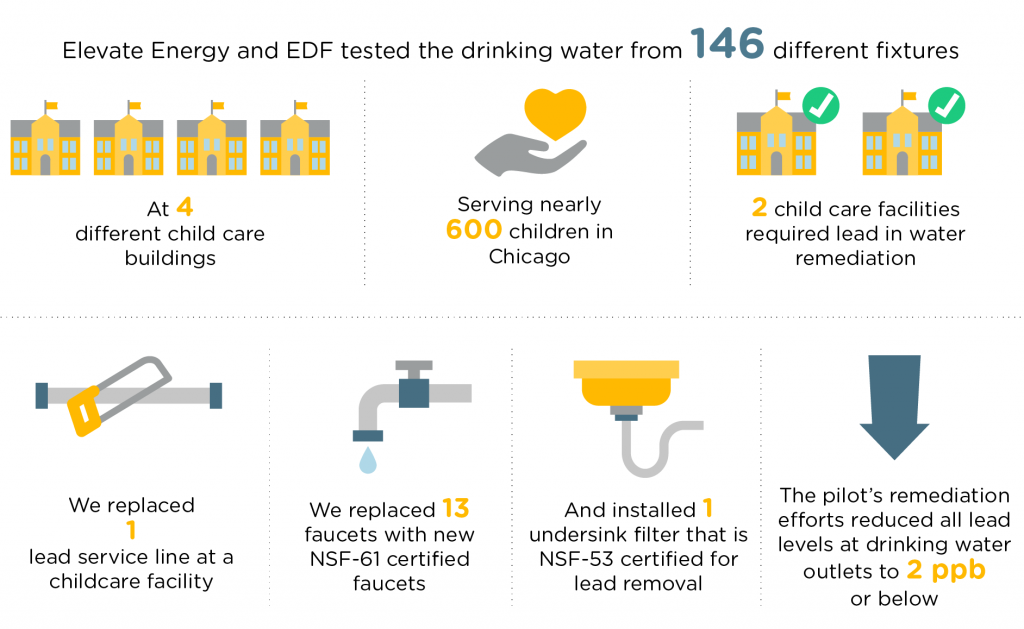Early Progress in Reducing the Risk of Lead Exposure in Water for Children in Illinois
 The Flint water crisis caused many of us to look at how our cities and states are addressing the risk of lead contamination in water. Illinois, along with six other states, is emerging as a leader in combating the risks of lead exposure in water by requiring testing at what to date has been a critical gap: child care facilities. Recent legislation in Illinois addresses the population of residents who are most at risk of the damaging effects of lead poisoning— children under the age of six. Until now, most child care facilities were not required to test their drinking water for lead.
The Flint water crisis caused many of us to look at how our cities and states are addressing the risk of lead contamination in water. Illinois, along with six other states, is emerging as a leader in combating the risks of lead exposure in water by requiring testing at what to date has been a critical gap: child care facilities. Recent legislation in Illinois addresses the population of residents who are most at risk of the damaging effects of lead poisoning— children under the age of six. Until now, most child care facilities were not required to test their drinking water for lead.
In Illinois, all licensed day care homes, day care centers, and group day care homes serving children aged birth to six years and built on or before January 1, 2000, must test their water for lead. The process will be rolled out by the Illinois Department of Children and Family Services (DCFS) in 2018. A pilot project provides valuable insights as these facilities begin to plan to comply with the requirement.
Why Child Care Facilities?
Children spend a lot of time at child care facilities and likely drink tap water and eat food prepared with water in these homes or buildings. The only way to confirm that a facility’s drinking water contains lead is to test it.
While lead exposure has health implications for all people, the effects are especially concerning among infants and children under the age of six. Children’s developing bodies absorb more of the lead they are exposed to than their adult counterparts. Further, exposure—even at low levels—can damage children’s developing brain and nervous system, contributing to lower IQ, hearing loss, and learning and behavior problems, in and out of the classroom.
A Window into the Water Testing and Lead Removal Process
The Environmental Defense Fund (EDF) conducted a pilot project to investigate new approaches for lead in water testing and remediation in child care facilities. The full report, Putting children first: Tackling lead in water at child care facilities is available online.
In Illinois, we partnered with EDF on the pilot to test and remove sources of lead at four nonprofit child care facilities in Chicago. These facilities provide affordable child care services to low-income communities.
Before testing water for lead, we investigated for the presence of a lead service line. When possible, best practice is to remove a lead service line as it can unpredictably release lead particulate into drinking water. In fact, when present, a lead service line can contribute an estimated 50 to 75 percent of lead in drinking water. If such a line was found, we hired a licensed plumbing contractor to remove it before beginning the lead in water testing process. Other sources of lead exposure in water include plumbing materials like lead solder and brass fixtures that leach lead into drinking water through a process called corrosion.
 Results from the Chicago pilot are encouraging: lead in water has been addressed for nearly 600 children at critical child care facilities in our state. Read this overview for more results and recommendations from the pilot.
Results from the Chicago pilot are encouraging: lead in water has been addressed for nearly 600 children at critical child care facilities in our state. Read this overview for more results and recommendations from the pilot.
“Testing drinking water for lead is a simple, important step that all child care facilities should take,” said Mario Perez, child care director at El Hogar Del Niño in Chicago. “Through this project, we found and removed a lead service line and were able to identify and replace several problematic drinking water fixtures at our facility. Our partnership with Elevate Energy and EDF has helped us take meaningful steps to better protect the children in our care.”
Collaboration on a Critical Goal
The Chicago pilot presents solutions and steps that child care facilities can take to reduce lead exposure at the tap. While compliance with the Illinois legislation will require a reasonable effort, the effort is critical to protect children, our most vulnerable population. Education, support, and funding is necessary, as is collaboration with a wide range of stakeholders, including child care facility operators, state agencies and health departments, water utilities, local plumbing contractors, and others. But together, we can help Illinois continue to serve as a model for other states.
“Children and infants are the most vulnerable to the health effects of lead exposure,” said Caroline Pakenham with Elevate Energy. “We hope other child care facilities will learn about the importance of testing their water for lead and that there are steps they can take to reduce lead levels.”
Please see these additional resources for more information.
- Chicago Child Care Pilot Fact Sheet
- Chicago Child Care Pilot: Lead Service Line Case Study
- EDF report, Putting children first: Tackling lead in water at child care facilities
- EPA’s 3Ts Guidance for Lead in Drinking Water provides useful information on short and long-term lead removal strategies (sections 5.2 and 5.3).



